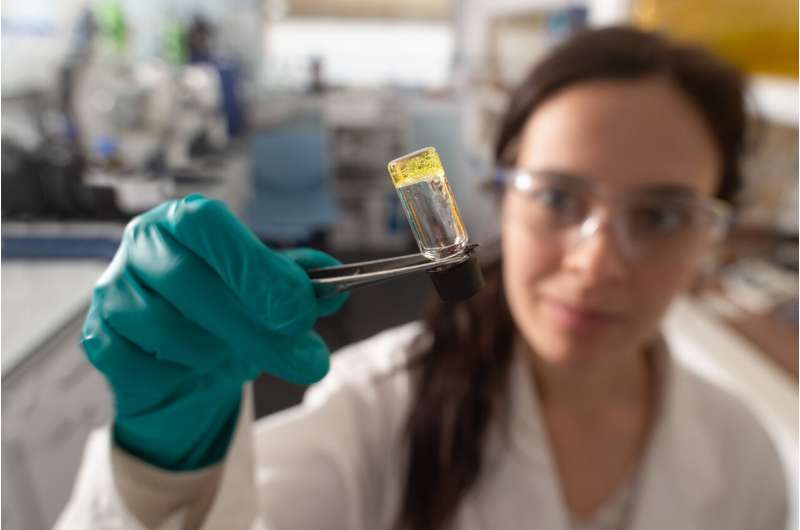Forging molecular bonds with green light

QUT researchers have created a new molecular coupling tool employing both green light and pH triggers that has potential for use in applications such as drug delivery and 3-D cell culture platforms.
Their research has been published in the journal Nature Communications.
The research was conducted by lead author and QUT Ph.D. chemistry researcher Kubra Kalayci, Australian Research Council (ARC) DECRA Fellow Dr. Hendrik Frisch, Research Fellow Dr. Vinh Truong, and ARC Laureate Fellow Professor Christopher Barner-Kowollik from QUT's Soft Matter Materials Laboratory in the Science and Engineering Faculty Center for Materials Science.
Professor Barner-Kowollik said scientists were constantly seeking to move further away from using harsh UV light to activate chemical reactions.
"Our photochemical innovation is another example of what is called red-shifting—moving through the colors of light in the spectrum, from blue to green towards red, to light that has longer wavelengths," he said.
"In the past, most of these types of photochemical reactions were triggered by harsh UV (ultra-violet) light. But that prevents applications in a biological context because UV light has so much energy it kills cells. Dentistry is an example of one of the areas that has shifted. Initially dentists were using UV lamps. Now anyone who has had a filling probably knows that the dentist uses a little lamp with longer wavelength blue light for curing. The longer the wavelength of light the better, in principle. The radiation is less harmful, so it can be used for biological applications, and it allows for deeper light penetration. For dentistry, that means better and more uniform curing. But it is also more difficult to do, because the longer the wavelength of light the less energy you have to drive the chemical reaction. Adding an additional stimulus with the green light, such as we have with varying the pH as a reversible on-off switch for the reaction, provides the opportunity for better regulation. This is especially important for drug delivery systems, where the drug needs to be released under a specific pH, as pH varies throughout the human body. This is also a catalyst-free reaction. It means there's no helper molecule to make it happen. That's important for biological application as well because in many cases helper molecules contain metal, and you don't want something that could leach out, or something that is found to be cytotoxic or carcinogenic."
To investigate the new green light-pH coupling tool's suitability for biomaterials engineering, Ms Kalayci said the research team created hydrogels with different properties.
"These showed that green light allowed higher penetration depths, resulting in fabrication of thicker hydrogels," she said.
Dr. Truong said cells cultured inside the hydrogels "showed the process for creating the gels was non-toxic, and the cells also remained viable for several days."
The team believes the new coupling tool has a range of other potential applications.
"For example, in the context of personalized medicine," Dr. Truong and Dr. Frisch said. "You might want to use our reaction to attach a cancer drug to a specific part of a molecule to deliver the drug in a way that is suited to a particular patient."
Professor Barner-Kowollik said it was also another step towards achieving "molecular surgery."
"What chemists hope to do is be able to 'operate' on one part of a molecule without affecting anything else," he said.
"So, for example, if you had a protein, a large complex molecule, we'd like to be able to use light like a chemical scalpel and very delicately go in and change part of that molecule without affecting any other part. That provides many potential applications."
Applications could include, Dr. Truong said, "looking at the selective crosslinking of DNA to study the underlying mechanism of a cancer, looking for avenues for targeted treatment, or creating dynamic hydrogel scaffolds to study cell interactions for tissue regeneration therapy.
"Using light, we are providing chemical tools to be able to achieve these aims."
More information: Kubra Kalayci et al. Green light triggered [2+2] cycloaddition of halochromic styrylquinoxaline—controlling photoreactivity by pH, Nature Communications (2020). DOI: 10.1038/s41467-020-18057-9
Journal information: Nature Communications
Provided by Queensland University of Technology




















